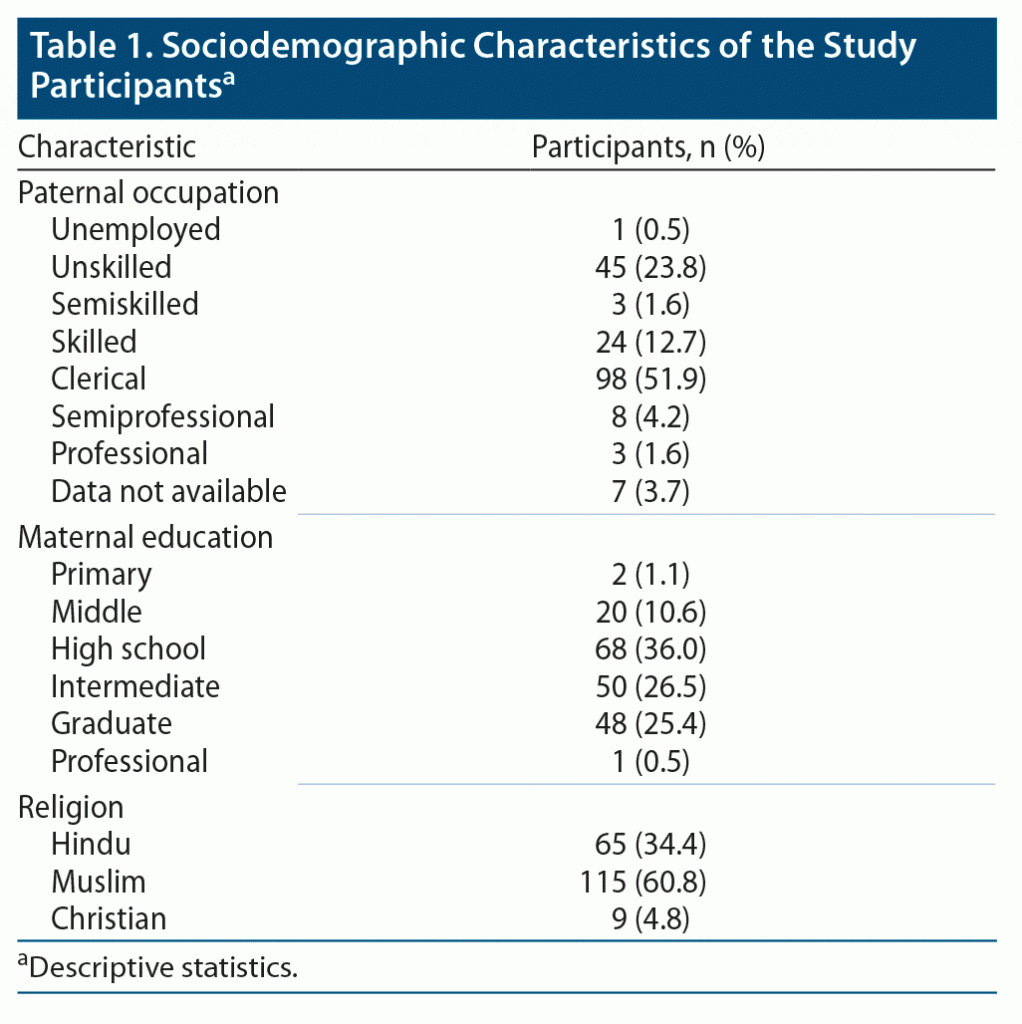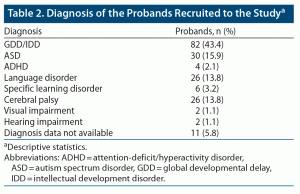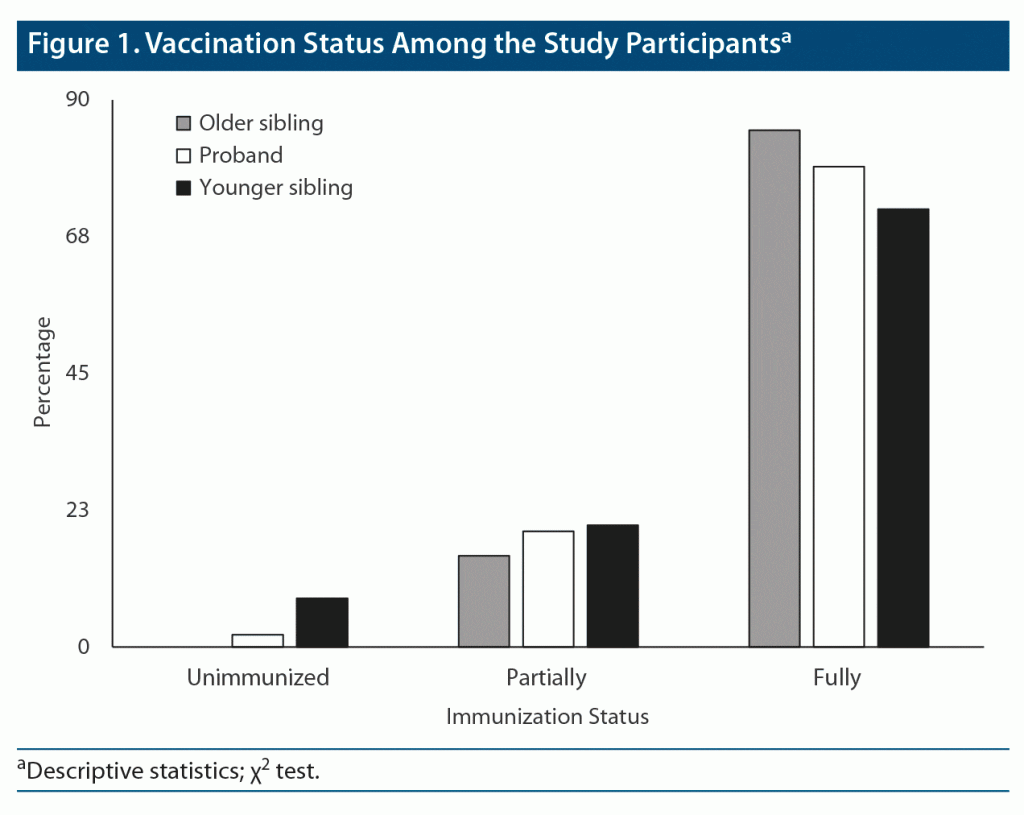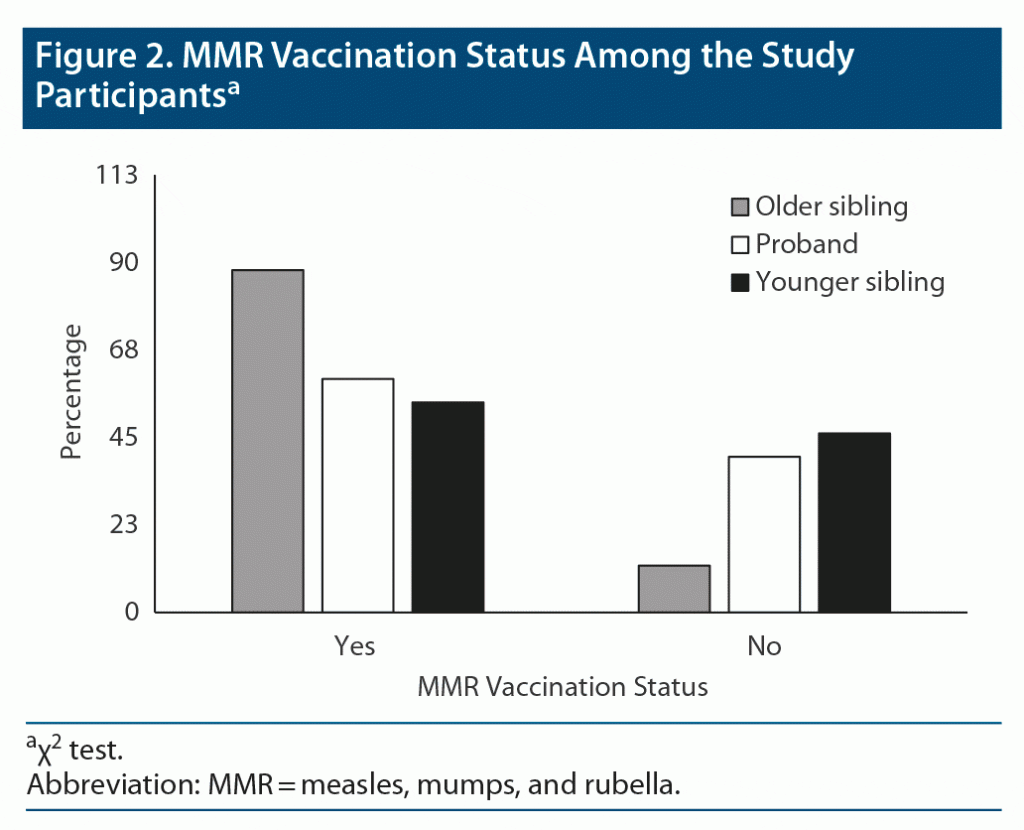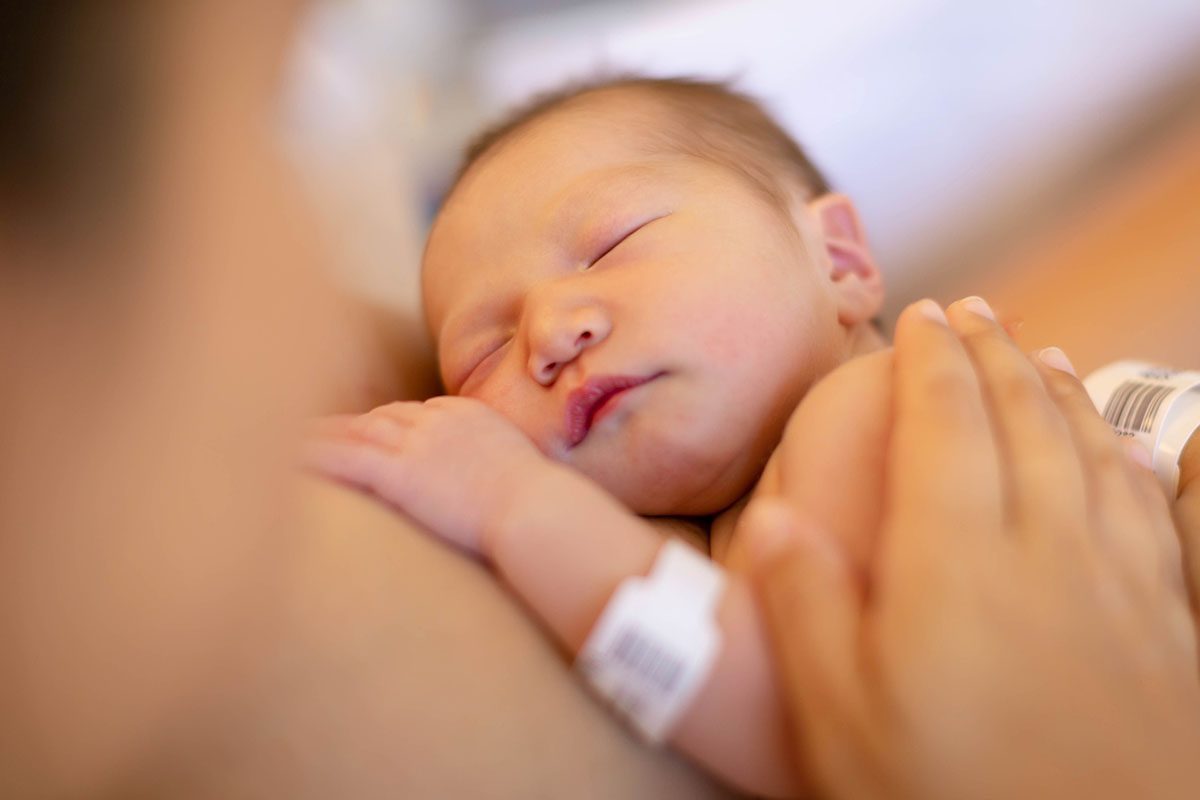ABSTRACT
Objective: Despite scientific evidence to the contrary, parental concerns with respect to the association between vaccination and development of autism spectrum disorder persist. The objective of this study was to assess the vaccination uptake and its associated factors in siblings of children with developmental delay.
Methods: This cross-sectional study was conducted from December 2017 to February 2018. The families of children with developmental delay, according to evaluation by a psychiatrist per ICD-10 criteria, were recruited from 3 child development centers. The data were collected using a semistructured questionnaire.
Results: 189 families with children with developmental delay were recruited into the study. In total, these children had 114 typically developing elder siblings and 50 typically developing younger siblings. The proportions of overall complete vaccination among the children with developmental delay group and the younger sibling group were significantly lower than the older sibling group (P < .01). The proportions of MMR (mumps, measles, and rubella) vaccination among the children with developmental delay group and the younger sibling group were significantly lower than the older sibling group (P < .001).
Conclusions: Findings from this study suggest that reduced vaccination uptake is a general trend in families of children with developmental delay. Such a significant decline in the vaccination rate in this group of children will make them vulnerable if outbreaks occur. Therefore, public health strategies targeted to improve vaccination rates in families of children with developmental delay are needed.
Prim Care Companion CNS Disord 2022;24(4):21m02952
To cite: Basheer S, Uvais NA. Vaccination behavior among children with developmental delay and their siblings: a cross-sectional study from India. Prim Care Companion CNS Disord. 2022;24(4):21m02952.
To share: https://doi.org/10.4088/PCC.21m02952
© Copyright 2022 Physicians Postgraduate Press, Inc.
aDepartment of Psychiatry, Iqraa International Hospital and Research Centre, Calicut, Kerala, India
*Corresponding author: N. A. Uvais, MBBS, DPM, Iqraa International Hospital and Research Centre, Calicut, Kerala, India ([email protected]).
Vaccination hesitancy and refusal have been an issue since the practice of vaccination began. Recent outbreaks of various vaccination preventable diseases have emphasized the public health importance of this issue. In 2019 alone, approximately 5.2 million children aged < 5 years died from preventable and treatable causes.1 Identification of the factors affecting vaccination behavior is essential to effectively tackle this problem. In developing countries like India, lack of access to vaccination and family characteristics such as low education, literacy, and socioeconomic status are the main reasons for poor vaccination among children.2
In addition to attitudinal factors and religious beliefs, perceiving vaccination to cause adverse effects was consistently associated with vaccine refusal.3 Although multiple studies3–5 have shown that there is no link between MMR (mumps, measles, and rubella) vaccine and development of autism spectrum disorder (ASD), this perceived link has influenced public vaccination behavior. This perceived link has been seen in previous studies4,5 that found decreased vaccination uptake in younger siblings of children with ASD.
However, there is a lack of studies exploring whether this trend of decreased vaccination uptake is a general phenomenon in families of children with developmental disabilities. Thus, the objective of this study was to compare the vaccination rate among children with developmental delay and their siblings and to assess whether there were changes in vaccination behavior between siblings. The vaccination behavior in elder and younger siblings without developmental delay was assessed as a part of the study. Elder siblings without developmental delay were conceptualized as a control group against which patients and their younger siblings were compared.
METHODS
This cross-sectional study was conducted from December 2017 to February 2018. The study protocol was approved by the Institute Ethics Committee, Iqraa International Hospital and Research Centre, Kozhikode, Kerala, India.
The families of children with developmental disabilities were recruited into the study from 3 child development centers in the districts of Kozhikode and Kannur in Kerala, India. The child development centers provide multidisciplinary services including physiotherapy, speech therapy, educational programs, and psychological interventions. The data were collected using a semistructured questionnaire by a trained therapist at each center. A purposive sampling technique was used to recruit participants. The trained therapists who took part in the study included a qualified speech therapist, a physiotherapist, and special educators. They were given information regarding the study and how to collect the data. These therapists were staff of the centers wherein the data were collected. The children who were participants in the study had been evaluated by qualified psychiatrists from whom the child was receiving treatment, and the diagnosis was done as part of routine clinical evaluation according to ICD-10 criteria. The diagnosis was recorded in the clinical files. The data regarding diagnosis were collected from these clinical files. No additional tools were used for diagnostic assessment. Although the current study involved qualified psychiatrists, they were not directly involved in clinical diagnosis as part of this study.
Immunization status was determined based on the national immunization schedule. MMR vaccination status at age 18 months was also recorded. The parents who participated in the study were asked if they had their children vaccinated according to the national immunization schedule. In addition, they were also asked if their children had received MMR vaccination. Informed consent was taken from the primary caregiver of the child prior to enrollment in the study.
Analysis
The data were entered in an Excel spreadsheet and analyzed using SPSS statistical package version 21. Descriptive statistics and χ2 tests were performed.
RESULTS
The study included 189 families with children with developmental disabilities. The mean ± SD age at evaluation of children with developmental disabilities was 7.7 ± 3.7 years, ranging from 1.5 to 19 years. The most common diagnosis among children with developmental delay was global developmental delay/intellectual development disorder (43.4%), followed by ASD (15.9%), language disorder (13.8%), and cerebral palsy (13.8%). No psychiatric comorbidities were reported. All children who were diagnosed with ASD were low functioning.
The diagnoses of the probands are summarized in Table 1. In total, these children had 114 typically developing elder siblings and 50 typically developing younger siblings. The mean ± SD of the elder siblings was 13.5 ± 5 years and that of the younger siblings was 5 ± 4 years.
The mean ± SD age of the fathers was 39 ± 6 years and that of the mothers was 32 ± 6 years. Around 52.4% of the mothers were educated above the high school level. The most common paternal occupation was clerical job (51.9%) followed by unskilled work (23.8%). The parental socio-occupational data are summarized in Table 2.
The proportion of overall complete vaccination among the children with developmental disabilities group (70%) and the younger sibling group (64%) was significantly lower than that of the older sibling group (85%, Pearson χ2, P < .01) (Figure 1). The proportion of MMR vaccination among the children with developmental disabilities group (60%) and the younger sibling group (59%) was significantly lower than that of the older sibling group (86%, Pearson χ2, P < .001) (Figure 2). There was no significant difference in the proportion of overall vaccination status and MMR vaccination status between index cases and younger siblings. Also, no association was found between vaccination status and sociodemographic variables such as parental education, paternal occupation, and religious beliefs.
DISCUSSION
In the current study, parents of children with developmental delay had incompletely vaccinated those children as well as their younger siblings, resulting in significantly lower immunization rates in probands and later-born children than in older siblings without developmental delay. This is the first study, to the best of our knowledge, that has compared vaccination behavior between affected children and their younger siblings to that of older siblings without developmental delay. Our findings have important implications for reduced herd immunity and increased vulnerability to vaccine-preventable illness in this high-risk group.
Our study results showed a significantly lower complete vaccination uptake among children with developmental delay compared with their older siblings. Although parents in the present study were not explicitly asked the reasons for incomplete immunizations, it could be related to both parental and primary care physicians’ attitudes. There are reports5 of a supportive role of primary care physicians in delaying immunization in vulnerable children such as those with developmental disabilities, which could have reinforced parental concern during the immunization visit. A meta-analysis3 investigating factors associated with vaccination of young children found that perceived adverse effects of the vaccine and vaccine recommendations by health professionals impact parental behavior.
Unlike our study, another similar study6 on vaccination uptake among siblings of children with ASD reported a decline in vaccination rate only among younger siblings and not in the index cases. This may be because diagnosis of ASD may be delayed compared to diagnosis of other developmental disorders. Thus, this delay in diagnosis of ASD might be the reason the vaccination rate did not decrease in the index cases.6
Speculation that the MMR vaccine may cause autism has been one of the most damaging controversies in vaccine safety, which was based on a since retracted report in 1998.7 Although multiple studies later found a negative association, some parents still believe this idea to be true, leading to the renewed outbreak of measles in the United States and resurgence of measles in Europe.8–10 Another controversy arose regarding the mercury-containing preservative thimerosal in the vaccine, which has also been feared to possibly increase the risk of autism. However, a meta-analysis11 of several epidemiologic studies found no increased risk of autism associated with thimerosal-containing vaccines. Other controversies were related to the association between vaccination and Guillain-Barré syndrome, its ability to cause chronic autoimmune diseases, and the association of aluminum adjuvants and macrophagic myofasciitis. However, studies12 failed to prove any of these associations.
Our study results also showed a significantly lower MMR vaccination rate among siblings of children with developmental delay compared to their older siblings. This finding may indicate that the parental anxiety regarding the possible association between immunization and autistic spectrum disorders may be having a spillover effect on vaccination behavior of families with children with developmental disabilities in general. This fear was raised in the mid-1990s following a study7 that argued that the MMR vaccine may lead to the development of ASD, despite multiple evidence to the contrary.8–10 Studies8 have also found an equal incidence and age at diagnosis of autism in vaccinated and unvaccinated children. Furthermore, epidemiologic data found no influence of MMR on the increased rate of reporting of autism to the General Practice Research database.13
Our study has the following limitations. The methodology was cross-sectional and clinical note based and was conducted at child development centers. No clinical evaluation of the study participants was done by psychiatrists to validate the recorded diagnosis in the clinical note. Moreover, absence of a control group without developmental delay also limits our interpretation of the study results. Furthermore, immunization status based on the knowledge of the parents in the absence of immunization data also was a limitation of our study. A prospective evaluation in a community sample with the involvement of psychiatrists in clarifying the diagnosis and with a control group of children without developmental delay could be done in the future for better understanding of vaccination behavior in this vulnerable group. Moreover, no policy recommendations were possible based on the present study, as it was a survey study. Further studies will be required to confirm our findings and to make policy recommendations.
CONCLUSION
Findings from this study suggest that reduced vaccination uptake is a trend in families of children with developmental delay attending child development centers in North Kerala. Previous studies of autism reported the decline in vaccination uptake only in younger siblings and not in the proband with autism. In our study, the reduced vaccination uptake was seen both in the proband (children with developmental delay) and in their younger siblings. A decline in the vaccination rate in this group of children attending child development centers will make them vulnerable in the case of outbreaks. Therefore, public health strategies targeted to improve the vaccination rates in families of children with developmental disabilities are needed.
Submitted: February 14, 2021; accepted June 10, 2021.
Published online: July 12, 2022.
Potential conflicts of interest: None.
Funding/support: None.
Clinical Points
- Greater understanding regarding the vaccination status in siblings of children with developmental disabilities is needed.
- The proportions of overall complete vaccination and MMR vaccination among children with developmental disabilities and the younger sibling group were significantly lower than in the older sibling group.
- Reduced vaccination uptake is a general trend in families of children with developmental delay.
References (13)

- World Health Organization. Children: improving survival and well-being. Accessed June 22, 2022. https://www.who.int/news-room/fact-sheets/detail/children-reducing-mortality
- Rainey JJ, Watkins M, Ryman TK, et al. Reasons related to non-vaccination and under-vaccination of children in low and middle income countries: findings from a systematic review of the published literature, 1999-2009. Vaccine. 2011;29(46):8215–8221. PubMed CrossRef
- Glickman G, Harrison E, Dobkins K. Vaccination rates among younger siblings of children with autism. N Engl J Med. 2017;377(11):1099–1101. PubMed CrossRef
- Kuwaik G, Roberts W, Brian J, et al. Immunization uptake in siblings of children with autism. Pediatrics. 2008;122(3):684–685, author reply 685–686. PubMed CrossRef
- Smith LE, Amlôt R, Weinman J, et al. A systematic review of factors affecting vaccine uptake in young children. Vaccine. 2017;35(45):6059–6069. PubMed CrossRef
- Kuwaik GA, Roberts W, Zwaigenbaum L, et al. Immunization uptake in younger siblings of children with autism spectrum disorder. Autism. 2014;18(2):148–155. PubMed CrossRef
- Wakefield AJ, Murch SH, Anthony A, et al. RETRACTED: Ileal-lymphoid-nodular hyperplasia, non-specific colitis, and pervasive developmental disorder in children. Lancet. 1998;351(9103):637–641. PubMed CrossRef
- Taylor B, Miller E, Farrington CP, et al. Autism and measles, mumps, and rubella vaccine: no epidemiological evidence for a causal association. Lancet. 1999;353(9169):2026–2029. PubMed CrossRef
- Madsen KM, Hviid A, Vestergaard M, et al. A population-based study of measles, mumps, and rubella vaccination and autism. N Engl J Med. 2002;347(19):1477–1482. PubMed CrossRef
- Smeeth L, Cook C, Fombonne E, et al. MMR vaccination and pervasive developmental disorders: a case-control study. Lancet. 2004;364(9438):963–969. PubMed CrossRef
- Taylor LE, Swerdfeger AL, Eslick GD. Vaccines are not associated with autism: an evidence-based meta-analysis of case-control and cohort studies. Vaccine. 2014;32(29):3623–3629. PubMed CrossRef
- DeStefano F, Bodenstab HM, Offit PA. Principal controversies in vaccine safety in the United States. Clin Infect Dis. 2019;69(4):726–731. PubMed CrossRef
- Farrington CP, Miller E, Taylor B. MMR and autism: further evidence against a causal association. Vaccine. 2001;19(27):3632–3635. PubMed CrossRef
Please sign in or purchase this PDF for $40.
Save
Cite
